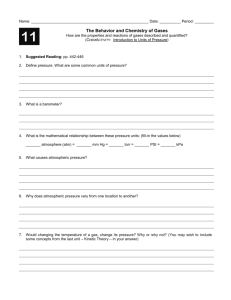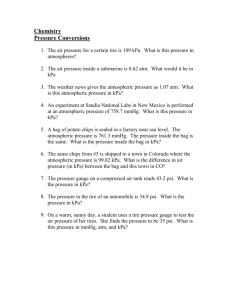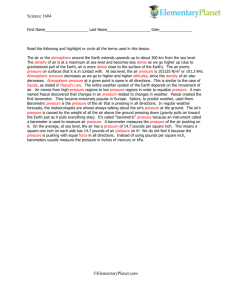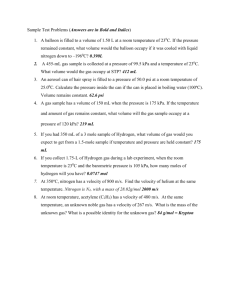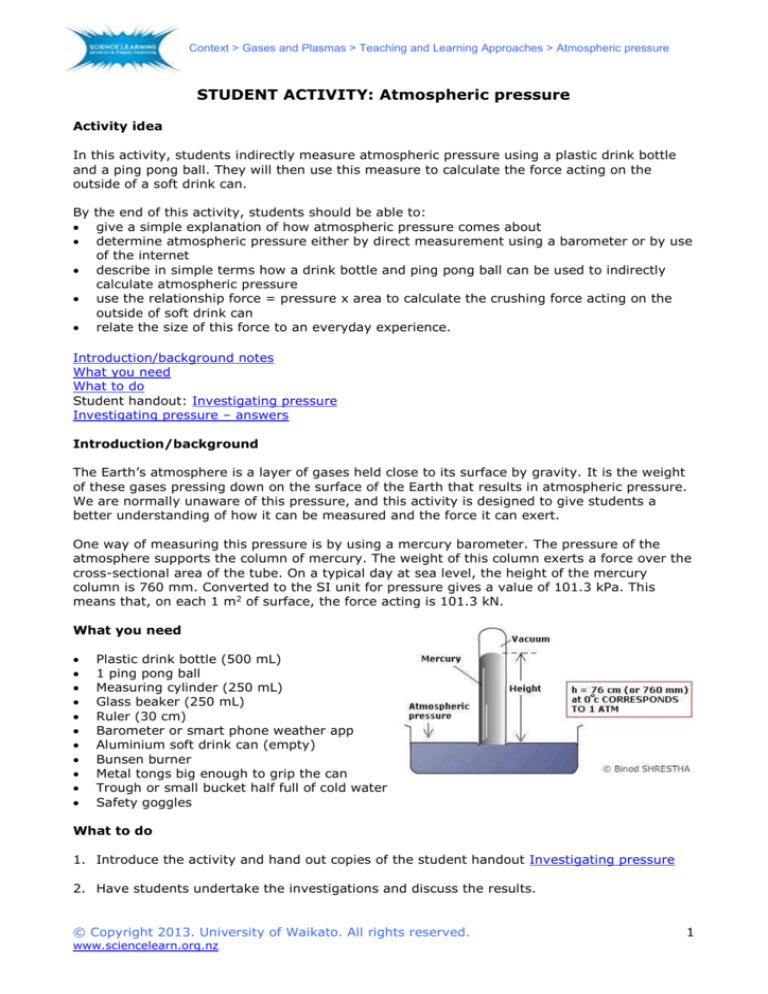
Context > Gases and Plasmas > Teaching and Learning Approaches > Atmospheric pressure
STUDENT ACTIVITY: Atmospheric pressure
Activity idea
In this activity, students indirectly measure atmospheric pressure using a plastic drink bottle
and a ping pong ball. They will then use this measure to calculate the force acting on the
outside of a soft drink can.
By the end of this activity, students should be able to:
give a simple explanation of how atmospheric pressure comes about
determine atmospheric pressure either by direct measurement using a barometer or by use
of the internet
describe in simple terms how a drink bottle and ping pong ball can be used to indirectly
calculate atmospheric pressure
use the relationship force = pressure x area to calculate the crushing force acting on the
outside of soft drink can
relate the size of this force to an everyday experience.
Introduction/background notes
What you need
What to do
Student handout: Investigating pressure
Investigating pressure – answers
Introduction/background
The Earth’s atmosphere is a layer of gases held close to its surface by gravity. It is the weight
of these gases pressing down on the surface of the Earth that results in atmospheric pressure.
We are normally unaware of this pressure, and this activity is designed to give students a
better understanding of how it can be measured and the force it can exert.
One way of measuring this pressure is by using a mercury barometer. The pressure of the
atmosphere supports the column of mercury. The weight of this column exerts a force over the
cross-sectional area of the tube. On a typical day at sea level, the height of the mercury
column is 760 mm. Converted to the SI unit for pressure gives a value of 101.3 kPa. This
means that, on each 1 m2 of surface, the force acting is 101.3 kN.
What you need
Plastic drink bottle (500 mL)
1 ping pong ball
Measuring cylinder (250 mL)
Glass beaker (250 mL)
Ruler (30 cm)
Barometer or smart phone weather app
Aluminium soft drink can (empty)
Bunsen burner
Metal tongs big enough to grip the can
Trough or small bucket half full of cold water
Safety goggles
What to do
1. Introduce the activity and hand out copies of the student handout Investigating pressure
2. Have students undertake the investigations and discuss the results.
© Copyright 2013. University of Waikato. All rights reserved.
www.sciencelearn.org.nz
1
Context > Gases and Plasmas > Teaching and Learning Approaches > Atmospheric pressure
Student handout: Investigating pressure
Calculating air pressure
1. Using a barometer or smart phone weather app, read off and record the atmospheric
pressure.
Atmospheric pressure __________kPa
2. Completely fill the plastic drink bottle with water and push the ping pong ball into the bottle
opening to remove a small amount of water.
3. Carefully pour off about one-third of the water in the bottle into a measuring cylinder and
read off and record the volume (V0).
Volume of water V0 = _____mL
4. Hold the ping pong ball over the bottle opening and
invert the bottle over the glass beaker. Hold the ball
loosely to allow a small amount of water to escape
from the bottle. Eventually, enough water will leak out
so that you can take your hand away and the ball will
remain in place.
5. Pour the leaked out water into the measuring cylinder
containing V0 and read off and record this new total
volume of water (V1).
Volume of water V1 = _____mL
6. Measure and record the distance (h) from the bottle
opening to the top of the water level in the bottle.
Distance ‘h’ = _____mm converted to metres =
______m
7. To calculate the atmospheric pressure (P0) using the recorded data, you need to consider
the pressures inside and outside the bottle. The pressure on the ping pong ball inside the
bottle comes from the reduced air pressure P1 and the static fluid pressure of the water
pressing on the ball. Since the ball remains in place, the pressure outside must equal the
pressure inside.
P0 = P1 + static fluid pressure of the remaining water
To calculate the static fluid pressure, multiply the density of water (), the gravitational
field constant (g) and the height (h) of the water column.
gh = 1000 kg/m3 x 9.8 N/kg x h = 9800 h
To calculate P0, use the following formula, part of which has been derived from the
application of Boyle’s Law.
P0 = gh [V1/(V1 – V0)]
= 9800 h [V1/(V1 – V0)]
= _________Pa
© Copyright 2013. University of Waikato. All rights reserved.
www.sciencelearn.org.nz
2
Context > Gases and Plasmas > Teaching and Learning Approaches > Atmospheric pressure
8. Compare your calculated result with the barometer reading or smart phone app reading.
‘Collapsing’ soft drink can
9. Measure and record the height and diameter of the empty soft-drink can.
10. Place a small amount of water in the can to just cover the bottom.
11. Wearing safety goggles, pick up the can with the metal tongs and hold over the lighted
Bunsen burner. Keep heating until there is a steady stream of steam coming out of the can
opening.
12. Quickly invert the can and place the upper third into the trough/bucket of cold water. Note
what happens.
13. Calculate the force on the can:
Height of the can
= ______cm = ______m
Diameter or the can
= ______cm = ______m
Barometric pressure
= ______kPa
Radius (r) = ______m
14. Calculate the surface area of the can:
Surface area of a cylinder
= area of the ends + area of the side
= 2r2 + 2rh
= ________ m2
15. Calculate the force being exerted on the outside of the can:
Force
= pressure x area
= ______ kPa x _____m2
= ______ kN
16. Comment on the size of this result.
17. Watch these YouTube clips:
www.youtube.com/watch?v=O9p8SRmQlPo
www.youtube.com/watch?feature=endscreen&v=JsoE4F2Pb20&NR=1
Questions about air pressure
Air pressure can be expressed in numerous ways:
The SI unit of pressure is the pascal (Pa) where 1Pa = 1 Nm-2.
Still in common usage is the atmosphere, which relates to the pressure exerted by the
weight of the atmosphere over the surface of the Earth. On an average day at sea level,
this pressure is known as 1 atmosphere, which equates to 101.325 kPa.
When inflating pneumatic tyres such as on cars and bicycles, the non-SI unit pounds per
square inch (psi) is frequently used: 1 atmosphere = 14.7 psi.
On a meteorological map, isobars are lines that connect points of equal air pressure. The
unit of pressure used is either the millibar (mb) or the hectopascal (hPa). One millibar is
equivalent to 100 Pa or one hectopascal.
© Copyright 2013. University of Waikato. All rights reserved.
www.sciencelearn.org.nz
3
Context > Gases and Plasmas > Teaching and Learning Approaches > Atmospheric pressure
100 kPa = 1000 hPa = 1000 mb
1 atmosphere = 760 mm of Hg = 14.7 psi = 101.3 kPa
18. The SI unit of pressure was named in honour of which French
scientist/mathematician/inventor/philosopher?
19. The central pressure within a high-pressure weather system was found to be 1028 hPa.
Convert this pressure to psi.
20. The tyre pressures used in competitive road cycling can be as high as 120 psi. Convert this
to pressure in kPa. Does the result you have calculated explain the sound effect heard
when a bicycle road tyre at this pressure punctures?
21. Blood pressure readings are taken in mm of Hg. A normal reading for an adult would be
120/80. The first reading (systolic pressure) is a measure of the maximum pressure when
the heart is pumping. Convert the 120 mm of Hg reading to psi. How does the heart
compare with a bicycle pump in terms of pressures achieved?
22. This diagram shows how a simple barometer
operates. Find out who it was that first
investigated air pressure through a system
like this.
© Copyright 2013. University of Waikato. All rights reserved.
www.sciencelearn.org.nz
4
Context > Gases and Plasmas > Teaching and Learning Approaches > Atmospheric pressure
Investigating pressure – answers
7. With h=0.25m; V1 = 160 mL; V0= 155 mL; h= 0.25 m then
P0 = 9800 x 0.26 x 160/(160-156)
= 101920 Pa
= 101.92 kPa
14. Calculate the surface area of the can:
A typical 330 mL soft drink can has a height of 12.25 cm and a diameter of 6.6 cm.
Surface area of a cylinder
=
=
=
=
=
=
area of the ends + area of the side
2r2 + 2rh
2 x 3.14 x 3.3 x 3.3 + 2 x 3.14 x 3.3 x12.25
68.39 + 253.87
253.87 cm2
0.0254 m2
15. Calculate the force being exerted on the outside of the can:
Assuming a total vacuum inside the can and an atmospheric pressure of 100 kPa:
Force = pressure x area
= 100 kPa x 0.0254 m2
= 2.54 kN
18. The SI unit of pressure was named in honour of which French
scientist/mathematician/inventor/philosopher?
Blaise Pascal (1623–1662). Impressed with the work of Evangelista Torricelli in trying to
prove that the atmosphere had weight, Pascal conducted experiments that showed a link.
One of them involved taking a barometer to the top of Poy de Dome, a mountain in central
France, and recording the readings during the ascent and descent. The higher up the
mountain he went, the lower the reading on the barometer. This result allowed him to
prove that the atmosphere had weight. In honour of his contributions to the understanding
of atmospheric pressure, it was decided at the General Conference on Weights and
Measures held in 1971 to name the SI unit of pressure the pascal. One pascal (Pa) equals
one newton per square metre.
19. The central pressure within a high-pressure weather system was found to be 1028 hPa.
Convert this pressure to psi.
If 101.3 kPa = 14.7 psi, then 1 kPa = 14.7/101.3 psi = 0.145 psi.
Now 1028 hPa = 102.8 kPa, so the answer is 102.8 x 0.145 = 14.9 psi.
20. The tyre pressures used in competitive road cycling can be as high as 120 psi. Convert this
to pressure in kPa. Does the result you have calculated explain the sound effect heard
when a bicycle road tyre at this pressure punctures?
If 0.145 psi = 1 kPa, then 1 psi = 1/0.145 kPa = 6.9 kPa. This means then that 120 psi =
120 x 6.9 = 828 kPa.
This is a huge pressure and when released rapidly, as in a ‘puncture’, would create the
characteristic sound effect.
© Copyright 2013. University of Waikato. All rights reserved.
www.sciencelearn.org.nz
5
Context > Gases and Plasmas > Teaching and Learning Approaches > Atmospheric pressure
21. Blood pressure readings are taken in mm of Hg. A normal reading for an adult would be
120/80. The first reading (systolic pressure) is a measure of the maximum pressure when
the heart is pumping. Convert the 120 mm of Hg reading to psi. How does the heart
compare with a bicycle pump in terms of pressures achieved?
Since 14.7 psi = 1 atm = 760 mm of Hg, then 1 psi = 760/14.7 = 51.7 mm of Hg. This
means that 120 mm of Hg = 120/51.7 psi = 2.32 psi.
Bicycle pumps need to be able to create pressures in excess of 120 psi whereas the heart
needs to develop a pressure of only 2.32 psi. However, given the average human lifespan
at 80 years and the fact that the heart is continuously pumping for that time period, the
heart is an extraordinarily efficient pump.
22. This diagram shows how a simple barometer operates. Find out who it was that first
investigated air pressure through a system like this.
Evangelista Torricelli (1608–1647) was an Italian
mathematician/physicist. In 1641, he moved to
the Italian town of Florence to work as an
assistant with Galileo. Whilst working on a
vacuum pump design problem, Galileo suggested
that Torricelli use mercury instead of water. This
led Torricelli to the development the first mercury
barometer in 1644. In his honour, the non-SI unit
of pressure known as the ‘torr’ is named after
him – 1 torr = 133.3 Pa 1 mm of Hg.
© Copyright 2013. University of Waikato. All rights reserved.
www.sciencelearn.org.nz
6

